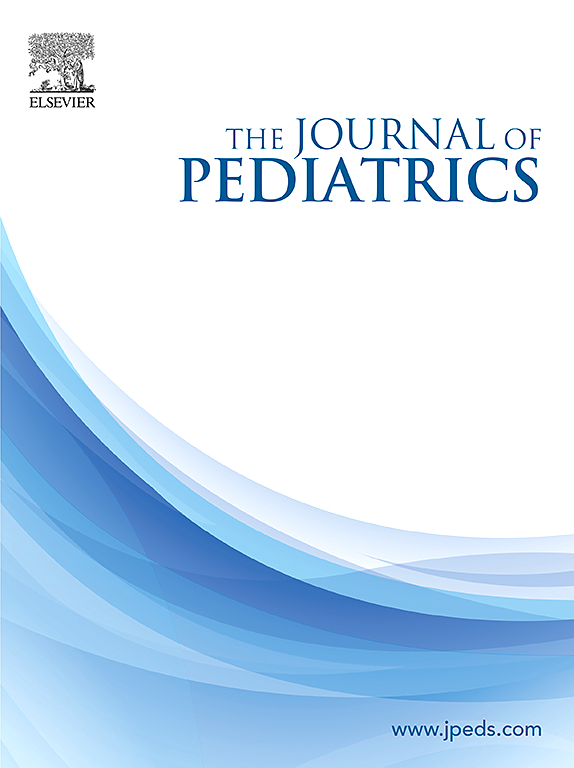Shwachman-Diamond综合征的生长模式:来自北美Shwachman-Diamond综合征登记处的发现。
IF 3.5
2区 医学
Q1 PEDIATRICS
引用次数: 0
摘要
目的:通过生成SDS特异性生长曲线,并评估造血干细胞移植(HSCT)和生长激素(GH)对生长的影响,来表征北美Shwachman-Diamond综合征(SDS)患者的生长模式。研究设计:我们进行了一项回顾性队列研究,纳入了在北美SDS登记处登记的127名确认双等位基因SBDS突变的受试者。分析身高、体重和bmi年龄z分数,并与疾病控制和预防中心(CDC)和世界卫生组织参考人群进行比较。评估HSCT和生长激素治疗对生长速度和最终身高的影响。结果:SDS个体表现出明显较低的年龄-身高z分数(HAZ),与CDC标准相比,成年身高中位数女性短约7厘米,男性短约11厘米。虽然体重随年龄的变化有所减少,但bmi随年龄的变化轨迹保持不变。HSCT显著降低了HAZ斜率,在小样本中,生长激素治疗对提高最终高度的效果有限。结论:这项在北美不同样本中进行的SDS研究扩展了这种罕见疾病的可用生长数据,证实了SDS患者持续身材矮小,但年龄BMI正常。HSCT与生长减少有关。生长激素治疗未观察到高度速度的显著变化。这些数据将为SDS患者的临床生长评估提供信息。本文章由计算机程序翻译,如有差异,请以英文原文为准。
Growth Patterns in Shwachman-Diamond Syndrome: Findings from the North American Shwachman-Diamond Syndrome Registry
Objective
To characterize growth patterns in individuals with Shwachman-Diamond syndrome (SDS) in North America by generating SDS-specific growth curves and assessing the impact of hematopoietic stem cell transplant (HSCT) and growth hormone (GH) on growth.
Study design
We conducted a retrospective cohort study of 127 subjects with confirmed biallelic Shwachman-Bodian-Diamond syndrome mutations enrolled on the North American SDS Registry. Height-for-age, weight-for-age, and body mass index (BMI)-for-age Z-scores were analyzed and compared with Centers for Disease Control and Prevention and World Health Organization reference populations. The effects of HSCT and GH therapy on growth velocity and final height outcomes were assessed.
Results
Individuals with SDS demonstrated significantly lower height-for-age Z-scores, with median adult height being approximately 7 cm shorter in females and 11 cm shorter in males compared with Centers for Disease Control and Prevention standards. Although weight-for-age was diminished, BMI-for-age trajectories were preserved. HSCT significantly reduced height-for-age Z-scores slope, and in a small subsample, GH therapy showed limited efficacy in improving final height.
Conclusions
This study of SDS across a diverse North American sample extends available growth data for this rare condition, confirming persistent short stature but normal BMI for age in SDS. HSCT was associated with a reduction in growth. No significant change in height velocity was observed with GH therapy. These data will inform clinical growth evaluation in SDS patients.
求助全文
通过发布文献求助,成功后即可免费获取论文全文。
去求助
来源期刊

Journal of Pediatrics
医学-小儿科
CiteScore
6.00
自引率
2.00%
发文量
696
审稿时长
31 days
期刊介绍:
The Journal of Pediatrics is an international peer-reviewed journal that advances pediatric research and serves as a practical guide for pediatricians who manage health and diagnose and treat disorders in infants, children, and adolescents. The Journal publishes original work based on standards of excellence and expert review. The Journal seeks to publish high quality original articles that are immediately applicable to practice (basic science, translational research, evidence-based medicine), brief clinical and laboratory case reports, medical progress, expert commentary, grand rounds, insightful editorials, “classic” physical examinations, and novel insights into clinical and academic pediatric medicine related to every aspect of child health. Published monthly since 1932, The Journal of Pediatrics continues to promote the latest developments in pediatric medicine, child health, policy, and advocacy.
Topics covered in The Journal of Pediatrics include, but are not limited to:
General Pediatrics
Pediatric Subspecialties
Adolescent Medicine
Allergy and Immunology
Cardiology
Critical Care Medicine
Developmental-Behavioral Medicine
Endocrinology
Gastroenterology
Hematology-Oncology
Infectious Diseases
Neonatal-Perinatal Medicine
Nephrology
Neurology
Emergency Medicine
Pulmonology
Rheumatology
Genetics
Ethics
Health Service Research
Pediatric Hospitalist Medicine.
 求助内容:
求助内容: 应助结果提醒方式:
应助结果提醒方式:


